Enforcement of immigration legislation statistics
Data extracted: 30 April 2024.
Planned update: May 2025.
Highlights
118 935 non-EU citizens were refused entry into the EU at one of its external borders in 2023, a decrease of 16.5% compared with 2022.
1.265 million non-EU citizens were found to be illegally present in the EU in 2023, up 12.9% compared with 2022.
484 160 non-EU citizens were ordered to leave the territory of the EU in 2023, an increase of 3.8% compared with 2022.
111 185 non-EU citizens were returned following an order to leave the EU in 2023, up 25.1% compared with 2022.
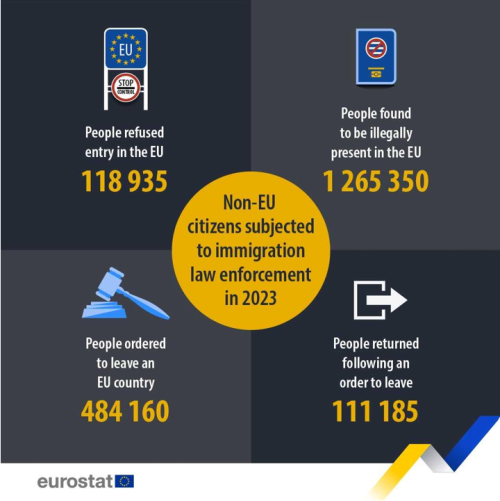
(number)
Source: Eurostat (migr_eirfs), (migr_eipre), (migr_eiord1) and (migr_eirtn1)
This article presents indicators on the enforcement of immigration legislation. It provides statistics on: third country or non-European Union (EU) citizens who were refused entry at the external borders of the EU [1]; non-EU citizens who were illegally present on the territory of a EU country; and non-EU citizens who were ordered to leave the territory of a EU country;[2]. Each of these indicators can be regarded as an official record of persons subject to the enforcement of EU immigration legislation, providing a general overview of the outcomes of territorial surveillance and control procedures.
Since 2020, the number of refusals of entry and returns has a similar stabilisation trend. In the same period, the number of citizens found to be illegally present in EU countries increased almost 27.0%. The number of return decisions (orders to leave) in 2023 is the second highest since 2014.
Full article
Non-EU citizens refused entry into the EU
In 2023, the number of non-EU citizens who were refused entry into the EU decreased by 16.5%
In 2023, nearly 118 935 non-EU citizens were refused entry into the EU at one of its external borders. Almost a quarter of the total number of refusals were recorded in Poland (12.5%) and in Hungary (10.6%) (Table 1).
Altogether, the eight EU Member States that recorded the highest numbers of non-EU citizens refused entry into the EU — Poland (14 850), Hungary (12 575), Croatia (10 900), Ireland (7 405), Greece (7 270), Spain (7 250), Bulgaria (7 230) and Romania (7 155) – accounted for nearly of two thirds (62.8%) of the total number refused entry into the EU in 2023.
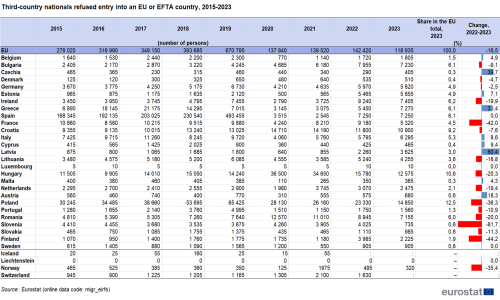
Source: Eurostat (migr_eirfs)
In 2023, the vast majority (60.7%) of non-EU citizens who were refused entry into the EU were stopped at the external land borders; the share of refusals at air borders was 35.7%, while only a small proportion (3.6%) of total refusals for entry into the EU were at sea borders (see Table 2)[3].
These differences in the type of border were largely influenced by the high shares of refusals recorded at external land borders in EU countries with a high number of refusals, namely Bulgaria, Greece, Croatia, Hungary, Poland and Romania, and also in Estonia and Lithuania (all over 70.0 %).
As regards air borders, Ireland had the highest number of refusals (6 840), followed by Spain (6 440) and Germany (5 815) in 2023.
The only Eu country that recorded more than 1 000 refusals at sea borders in 2023 were France (1 345) and Italy (1 225).
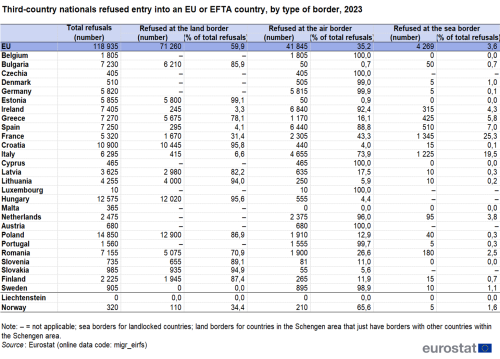
Source: Eurostat (migr_eirfs)
The highest number of persons refused entry into the EU in 2023 was for Ukrainians
Figure 2 shows the most common origins of citizens refused entry into the EU in 2023, with the data analysed according to the type of border that they were trying to cross. The highest number of citizens refused entry into the EU in 2023 were recorded for Ukrainians (18 325), followed by Albanians (13 845), Moldovans (9 795), Russian (8 255) and Turkish (7 365).
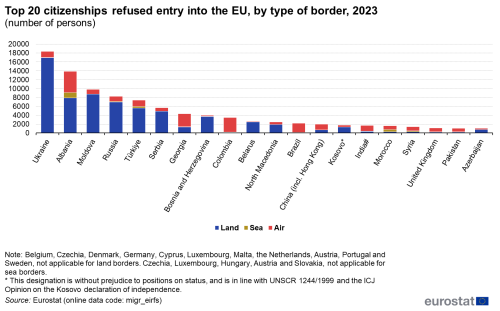
(number)
Source: Eurostat (migr_eirfs)
Citizens from the following countries were mainly refused entry into the EU at land borders – Ukraine (16 940, (92.5%)), Albania (7 860, (56.8%)), Moldova (8 760, (89.4%)), Russia (6 985, (84.6%)) and Türkiye (5 640, (76.6%)).
Regarding air borders, from the Top 20 countries of citizenship refused entry into EU during 2023, the highest number was reported for citizens of Albania (4 780, (34,5%)), Colombia (3 315, (95,4%)) and Georgia (2 925, (68,9%)). At sea borders, the highest numbers were registered for the citizens of Morocco (490, (30.4%)), Syria (170, (12.4%)) and Pakistan (115, (10.7%)).
Table 3 presents a summary of the three main groups of non-EU citizens by type of border for the EU countries and EFTA countries (subject to data availability).
Ukrainian citizens who were refused entry into the EU mainly tried to cross land borders with Poland and Hungary, and to a lesser extent with Romania and Slovakia. The majority of Albanian citizens were refused entry at Croatian, Hungarian or Greek land borders, or at Italian sea and air borders. The majority of Moldovans were refused entry at Romanian, Hungarian, Latvian or Polish land borders.
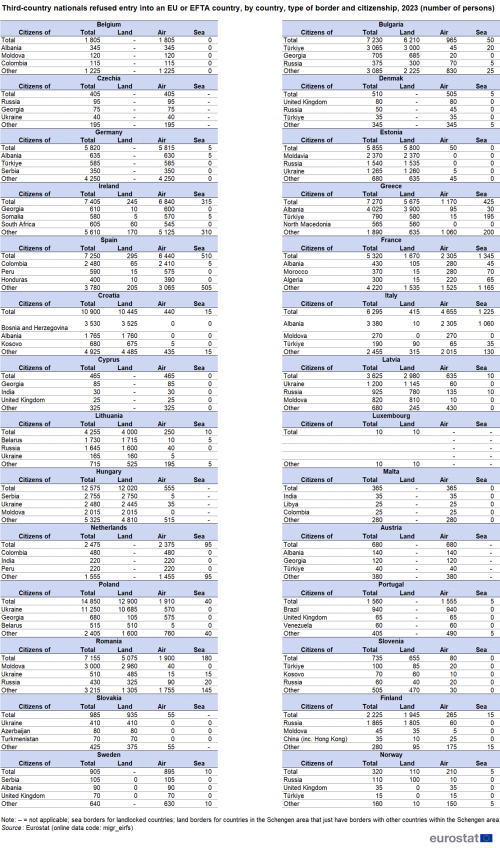
Source: Eurostat (migr_eirfs)
Almost 50% of refusals of entry in EU countries resulted from the absence of a valid visa or residence permit or for no justified purpose and conditions of stay
In 2023, the main reasons for refusals at borders, which are based on the Schengen Borders Code, were a lack of valid visa or residence permit (23.3%) and no justified purpose and conditions of stay (22.5%).
The main reasons for refusing entry to the EU to Ukrainians (18 325) in 2023 were the reasons ‘Persons already stayed 3 months in a 6-months period’ (40.4 % of the total refusals of Ukrainians in the EU) and ’No valid visa or residence permit’ (23.7 %). Albanian citizens were mainly refused entry (13 850) by ‘An alert has been issued’ (29.4%) and by the ‘Purpose and conditions of stay not justified’ (27.4%). Moldovan citizens were refused entry (9 805) for the reasons of ‘Purpose and conditions of stay not justified’ (38.8%) and ‘An alert has been issued’ (30.3%).
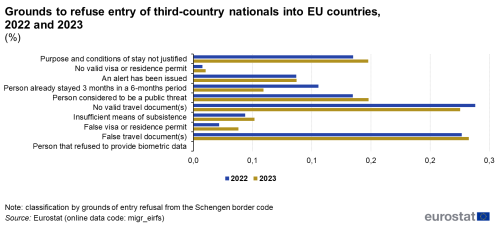
(%)
Source: Eurostat (migr_eirfs)
Non-EU citizens found to be illegally present
1 265 350 non-EU citizens were found to be illegally present in the EU in 2023, an increase of 12.9% compared with 2022
Germany reported the largest number of non-EU citizens found to be illegally present in 2023 (263 670), followed by Italy (194 750) and Hungary (159 780); these three Member States together accounted for 48.9 % of all non-EU citizens found to be illegally present in the EU (Table 4).
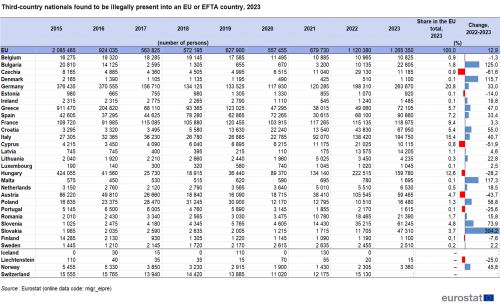
Source: Eurostat (migr_eipre)
Relative to the population, the rate of non-EU citizens found to be illegally present in the EU in 2023 by thousand inhabitants was 2.8. The countries where the number of non-EU citizens found to be illegally present per thousand inhabitants was the highest are Ireland (28.9), Czechia (17.6), Sweden (16.6) and Poland (11.0). Germany (0.9), Greece (0.7), Estonia (0.4), Romania (0.4), Croatia (0.3), Latvia (0.2), Austria (0.2) and Luxembourg (0,2) are the countries where the number of non-EU citizens found to be illegally present per thousand inhabitants is less than one (Map 1).
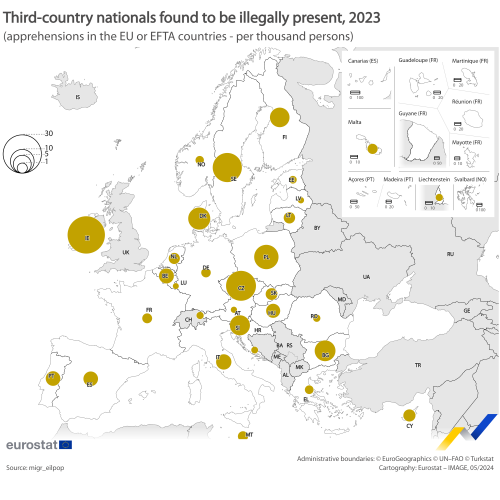
Source: Eurostat (migr_eipre)
In 2023, Syrian citizens accounted for the highest number of non-EU citizens found to be illegally present in the EU
Syrians accounted for the highest number of people found to be illegally present in the EU in 2023 at 252 900, with an increase of 28.4% compared with the previous year (Table 5). The next highest numbers in 2023 were recorded for citizens of Afghanistan (112 560) and Türkiye (83 520). These three countries represent more than one third of all the non-EU citizens found to be illegally present in the EU (35.5%).
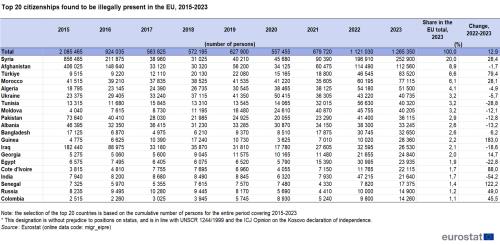
Source: Eurostat (migr_eipre)
Non-EU citizens ordered to leave the EU
Orders to leave issued to non-EU citizens in 2023 have increased by 3.8%
In 2023, 484 160 orders to leave were issued in the EU to non-EU citizens, 3.8% more than in 2022 (Table 6).
France issued the highest number of orders to leave (137 730; 32.0%), followed by Spain (64 260; 13.3%) and Germany (44 620; 10.4%).
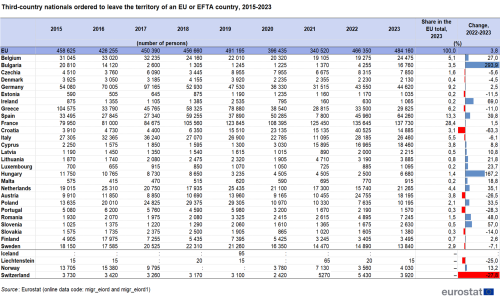
Source: Eurostat (migr_eiord) and (migr_eiord1)
The highest number of orders to leave an EU country territory in 2023 was issued to the citizens of Morocco (49 260), Algeria (38 145) and Afghanistan (23 475) (Figure 4).
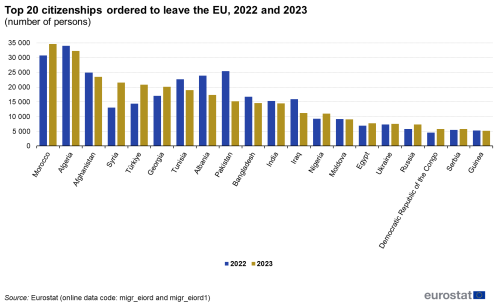
(number)
Source: Eurostat (migr_eiord) and (migr_eiord1)
Returns of non-EU citizens
In 2023, the number of non-EU citizens returned to another country following an order to leave increased by 25.1%
In 2023, 111 185 non-EU citizens were returned to another country following an order to leave an EU country territory.
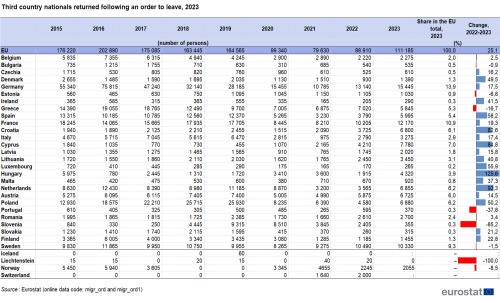
Source: Eurostat (migr_eirtn) and (migr_eirtn1)
The three EU countries that recorded the highest number of returns of non-EU citizens following an order to leave were Germany (15 445; 14.0%), France (12 170; 11.0%) and Sweden (10 330; 9.3%). Together, they accounted for almost one third of the total number of returns in 2023 (34.3%).
In 2023, over four-fifths (91 464; 82.3%) of all returns were returns to third countries (outside EU), an increase of 81.4% compared with 2022 (Figure 5).
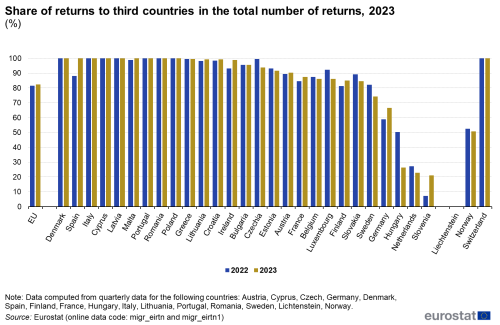
(%)
Source: Eurostat (migr_eirtn)
The highest number of returns outside EU in 2023 were reported for Georgians (10 345 returned to a third country from a total of 11 060 returns), Albanians (7 810 from a total of 8 180) and Turkish (5 595 from a total of 6 785), followed by Indians (2 780 from a total of 5 065) and Moldovans (3 375 from a total of 4 835) (Figure 6).
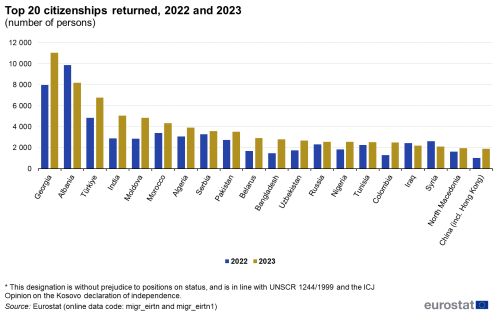
(number)
Source: Eurostat (migr_eirtn) and (migr_eirtn1)
Type of return and assistance received
In recent years, there has been increased demand for more detailed information on the enforcement of immigration legislation, leading to the development of new statistics on returns (including the collection of statistics on returns by type of return and assistance received). See the methodological note on derogations that were granted to EU countries in the ’Data sources’ chapter of this article.
Based on the information that is available for 26 EU countries for 2023, 43.1% of returns concerned people who left the territory voluntarily, while 56.9% were forced returns (Figure 7). In Germany, Hungary and Italy all reported returns were forced returns whereas in Denmark, Latvia and Lithuania the voluntary returns represented more than 90% of all returns. It should however be noted that reporting of voluntary returns is only limited to those returns which are reliably recorded by the national authorities, therefore those returns which are not or cannot be fully documented are not part of this data collection.
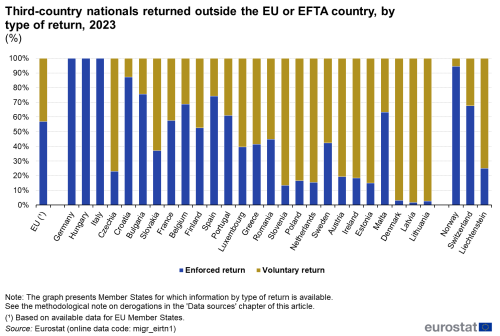
(%)
Source: Eurostat (migr_eirtn1)
To facilitate the return of non-EU citizens there are certain assisted return programmes funded by the EU, national or international organisations to provide reintegration support for returnees. This may include administrative, logistical and/or financial support to migrants who return to their country of origin.
In 2023, based on the information available for 26 EU countries, 72.4% were assisted returns and 27.6% were non-assisted returns (Figure 8).
In Germany, Spain, Italy and Hungary all the reported returns were assisted, while the majority of non-EU citizens returning from Estonia, Poland, Netherlands, Slovenia, Latvia and Lithuania were not assisted (for these six countries, assisted returns represented less than 25%).
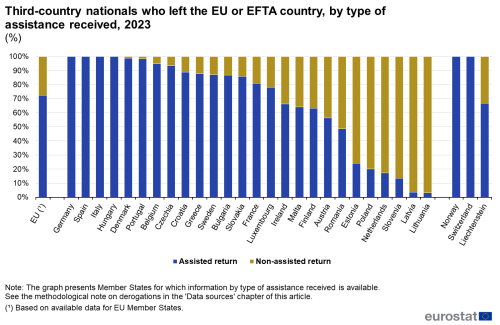
(%)
Source: Eurostat (migr_eirtn1)
Source data for tables and graphs
Data sources
The “Enforcement of Immigration Legislation statistics – Statistics Explained” article presents statistics regarding to 'non-EU citizens' (used as a synonym of 'third-country national', meaning any person who is not citizen of the European Union) refused to entry, apprehended for illegal staying, ordered to leave and returned following an order to leave, registered by EU and EFTA countries.
Statistics on the enforcement of immigration legislation are based on administrative data provided by national authorities in line with the requirements of Regulation (EC) No 862/2007 concerning statistics on migration and international protection. The compilation of these statistics draws on the terms used by the Schengen Borders Code, an EU code on the rules governing the movement of persons across borders (Regulation (EU) No 2016/399); for more information on the Schengen area, see here.
Statistics on the enforcement of immigration legislation exclude outgoing asylum seekers who are transferred from one EU Member State to another under the mechanism established by the Dublin Regulation (Regulation (EC) No 1560/2003 and Regulation (EU) No 604/2013); these cases are covered by Dublin statistics.
Note that the data for the number of non-EU citizens presented in the text of this article have been rounded to the nearest one hundred, for ease of reading and comprehension: more precise values (rounded to the nearest five) are shown in the tables and figures. Due to the rounding, various totals (such as for the EU) may not necessarily match the sum of the values for their components (such as the sum of values for the EU Member States).
In relation to the statistics presented in this article the following derogations were granted to Member States based on Commission Implementing Decision (EU) 2021/431 of 10 March 2021:
1) For data on Persons found to be illegally present:
- Transmission of the disaggregations by grounds for apprehension and by place of apprehension:
- Belgium, Lithuania and Portugal for the reference year 2021
- Czechia, Spain, France, Cyprus, Romania and Sweden for the reference years 2021-2023
2) For the data on Persons returned following an order to leave:
- Transmission of the disaggregations by the assistance received
- Czechia for the reference years 2021-2023
- Transmission of the disaggregations by the country of destination
- The Netherlands for the reference years 2021-2022
- Transmission of the disaggregations by the type of return and assistance received and by the country of destination
- Lithuania for the reference year 2021
- Spain, Cyprus and Sweden for the reference years 2021-2023
3) For the data on Persons ordered to leave and Persons returned following an order to leave:
- Transmission of the disaggregation by unaccompanied minors
- Belgium, Lithuania and Portugal for the reference year 2021
- Czechia, Spain, Cyprus, the Netherlands and Romania for the reference years 2021-2023
Tables in this article use the following notation:
| Value in italics | data value is forecasted, provisional or estimated and is therefore likely to change; |
| : | not available, confidential or unreliable value; |
| — | not applicable. |
Context
The enforcement of migration law refers to two main subjects: controlling the EU's external borders and the management of unauthorised non-EU citizens found on the territory of an EU Member State. Control of the EU's external borders constitutes one of the pillars for the creation of a freedom, security and justice area. The most noteworthy developments concern a harmonised set of rules governing the movement of persons across borders (the Schengen Borders Code published by Regulation (EU) No 2016/399); a comprehensive approach for European integrated management at the EU's border and efficient and effective management of border crossing and EU returns policy, respecting fundamental rights, and safeguarding free movement, operated by the European Border and Coast Guard Agency (Regulation (EU) No 2019/1896); an extensive package on automated border control was introduced (namely the Entry-Exit System established by (namely the Entry-Exist System established by the Regulation (EU) No 2017/2225 and Regulation (EU) No 2017/2226, and the European Traveler Information and Authorisation System established by Regulation (EU) No 2018/1240 and Regulation (EU) No 2018/1241).
The management of irregular migrant populations involves the finding of illegally present persons, the recognition of a decision of an order to leave and the effective return. The main legal instrument, the so-called Return Directive (Return Directive (2008/115/EC)), came into force at the end of 2010 establishing common standards for returning non-EU citizens illegally staying in the EU. The directive provides for clear, transparent, common and fair rules for return and removal, the use of coercive measures, detention and re-entry, while respecting the human rights and fundamental freedoms of the persons concerned. The EU also aims to promote a more effective return system (Policy Document Towards an Operational Strategy for more Effective Returns - COM/2023/45 Final), aimed at achieving, as an operational goal, among others, the improvement of data and statistical evidence-based on return, building a more targeted, planned and efficient return policy, and a common operational response capability. Several Schengen Area member countries have temporarily reintroduced the border control at internal borders pursuant to Article 25 and 28 et seq. of the Schengen Borders Code (with several reasons, for instance significant high pressure of irregular migration flows, smuggling and trafficking of human beings, secondary movements; organised criminal and terrorism threats; relevant events that could enhance migration flows and or criminal or terrorism threats) (Member States’ notifications of the temporary reintroduction of border control at internal borders).
As regards measuring the enforcement of immigration legislation, the progress made so far on collecting harmonised data results from the adoption of Regulation (EC) No 862/2007, in particular Articles 5 and 7. This regulation aims to support evidence-based decision-making, providing specifications concerning the data that should be submitted by EU countries on the number of non-EU citizens refused entry at the EU's external borders, the number of non-EU citizens apprehended for being illegally present in the EU, and the number of non-EU citizens who were removed from the EU as a result of their presence being unauthorised. Irregular migration remains a phenomenon difficult to quantify, especially during times when an effective and humane 'returns policy' is considered by many to form an essential part of migration policy.
Regulation (EC) No 2020/851 amended Regulation (EC) No 862/2007 aimed at, among other commitments, establishing a framework for a quick response to changing needs regarding statistics on migration and international protection, as well to promoting the data collection on a sub-annual basis in order to respond to the main needs for study, formulation and evaluation of migration and developing human-rights-based policies, and enhancing the knowledge of migration and international protection and migratory movements within European Union countries.
Notes
- ↑ EU aggregates are computed as the sum of the national statistics available for the EU countries. It is possible that the statistics for the EU involve some double counting of individuals if they are found to be illegally present in more than one Member State.
- ↑ Statistics on the enforcement of immigration legislation refer to the concept of external borders for all EU countries and EFTA countries, even if some of these are not in the Schengen area. The external borders of the Schengen area do not coincide with the external borders of the EU Member States due to: opt-outs for Ireland from the Schengen area; Bulgaria, Cyprus and Romania are not yet members of the Schengen area in 2023; Iceland, Liechtenstein, Norway and Switzerland are part of the Schengen area but are not members of the EU.
- ↑ Note that some of the EU Member States are landlocked and hence, by definition, do not have any sea borders, while others have only internal land borders within the Schengen area. The compilation of statistics on refused entry by countries within the Schengen area generally only concerns external borders of the Schengen area, although internal borders may be considered in exceptional cases, such as when a temporary border control is introduced between Schengen members.
Direct access to
- Enforcement of Immigration Legislation (migr_eil)
- Third country nationals refused entry at the external borders - annual data (rounded) (migr_eirfs)
- Third country nationals found to be illegally present - annual data (rounded) (migr_eipre)
- Third country nationals ordered to leave - annual data (rounded) (migr_eiord)
- Third country nationals ordered to leave by citizenship, age and sex - quarterly data (rounded) (migr_eiord1)
- Third-country unaccompanied minors ordered to leave, by citizenship, age and sex of the minor – quarterly data (rounded) (migr_eiord2)
- Third country nationals returned following an order to leave - annual data (rounded) (migr_eirtn)
- Third-country nationals returned following an order to leave, by type of return, citizenship, country of destination, age and and sex – quarterly data (migr_eirtn1)
- Third-country unaccompanied minors returned following an order to leave, by type of return, citizenship, country of destination, age and sex of the minor – quarterly data (rounded) (migr_eirtn2)
- Third-country nationals who have left the territory by type of return and citizenship (migr_eirt_vol)
- Third-country nationals who have left the territory by type of assistance received and citizenship (migr_eirt_ass)
- Third-country nationals who have left the territory to a third country by type of agreement procedure and citizenship (migr_eirt_agr)
- Third-country nationals who have left the territory to a third country by destination country and citizenship (migr_eirt_des)
- Enforcement of Immigration Legislation (ESMS metadata file — migr_eil_esms)
- Communication COM(2004) 412 final of 4 June 2004: Study on the links between legal and illegal migration
- Communication (COM(2018) 250 final of 14 March 2018: Progress report on the Implementation of the European Agenda on Migration
- Pact on Migration and Asylum of the EU
- Directive2008/115/EC on common standards and procedures in Member States for returning illegally staying third-country nationals
- Policy Document Towards an operational strategy for more effective returns (COM/2023/45 final)
- Regulation (EC) No 862/2007 on Community statistics on migration and international protection (Articles 5 and 7)
- Regulation (EU) 2020/851 of the European Parliament and of the Council of 18 June 2020 amending Regulation (EC) No 862/2007 on Community statistics on migration and international protection
- Regulation (EU) 2019/1896 of the European Parliament and of the Council of 13 November 2019 on the European Border and Coast Guard and repealing Regulations (EU) No 1052/2013 (EUROSUR) and (EU) 2016/1624 (European Border and Coast Guard)
- Regulation (EU) 2016/399 of the European Parliament and of the Council of 9 March 2016 on a Union Code on the rules governing the movement of persons across borders (Schengen Borders Code)
- 2024 State of Schengen report
- Member States’ notifications of the temporary reintroduction of border control at internal borders pursuant to Article 25 and 28 et seq. of the Schengen Borders Code
- Regulation (EU) 2017/2225 of the European Parliament and of the Council of 30 November 2017 amending Regulation (EU) 2016/399 as regards the use of the Entry/Exit System
- Regulation (EU) 2017/2226 of the European Parliament and of the Council of 30 November 2017 establishing an Entry/Exit System (EES) to register entry and exit data and refusal of entry data of third-country nationals crossing the external borders of the Member States and determining the conditions for access to the EES for law enforcement purposes, and amending the Convention implementing the Schengen Agreement and Regulations (EC) No 767/2008 and (EU) No 1077/2011
- Regulation (EU) 2018/1240 of the European Parliament and of the Council of 12 September 2018 establishing a European Travel Information and Authorisation System (ETIAS) and amending Regulations (EU) No 1077/2011, (EU) No 515/2014, (EU) 2016/399, (EU) 2016/1624 and (EU) 2017/2226
- Regulation (EU) 2018/1241 of the European Parliament and of the Council of 12 September 2018 amending Regulation (EU) 2016/794 for the purpose of establishing a European Travel Information and Authorisation System (ETIAS)
- Regulation (EU) 2018/1860 of the European Parliament and of the Council of 28 November 2018 on the use of the Schengen Information System for the return of illegally staying third-country nationals
- Regulation (EU) 2018/1861 of the European Parliament and of the Council of 28 November 2018 on the establishment, operation and use of the Schengen Information System (SIS) in the field of border checks, and amending the Convention implementing the Schengen Agreement, and amending and repealing Regulation (EC) No 1987/2006
- Regulation (EU) 2018/1862 of the European Parliament and of the Council of 28 November 2018 on the establishment, operation and use of the Schengen Information System (SIS) in the field of police cooperation and judicial cooperation in criminal matters, amending and repealing Council Decision 2007/533/JHA, and repealing Regulation (EC) No 1986/2006 of the European Parliament and of the Council and Commission Decision 2010/261/EU
